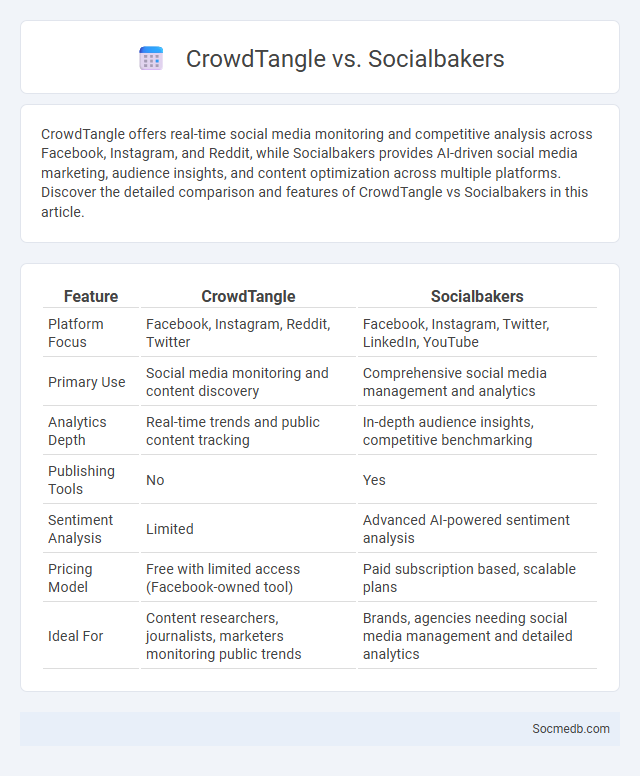
Photo illustration: CrowdTangle vs Socialbakers
CrowdTangle offers real-time social media monitoring and competitive analysis across Facebook, Instagram, and Reddit, while Socialbakers provides AI-driven social media marketing, audience insights, and content optimization across multiple platforms. Discover the detailed comparison and features of CrowdTangle vs Socialbakers in this article.
Table of Comparison
| Feature | CrowdTangle | Socialbakers |
|---|---|---|
| Platform Focus | Facebook, Instagram, Reddit, Twitter | Facebook, Instagram, Twitter, LinkedIn, YouTube |
| Primary Use | Social media monitoring and content discovery | Comprehensive social media management and analytics |
| Analytics Depth | Real-time trends and public content tracking | In-depth audience insights, competitive benchmarking |
| Publishing Tools | No | Yes |
| Sentiment Analysis | Limited | Advanced AI-powered sentiment analysis |
| Pricing Model | Free with limited access (Facebook-owned tool) | Paid subscription based, scalable plans |
| Ideal For | Content researchers, journalists, marketers monitoring public trends | Brands, agencies needing social media management and detailed analytics |
Overview: CrowdTangle vs Socialbakers
CrowdTangle excels in real-time social media monitoring and content discovery, providing actionable insights through influencer tracking and competitive analysis across platforms like Facebook, Instagram, and Twitter. Socialbakers offers advanced AI-driven analytics and audience segmentation, enabling businesses to optimize content strategy and measure campaign performance with data from Facebook, Instagram, LinkedIn, Twitter, and YouTube. Both tools support comprehensive social listening but differ in their emphasis, with CrowdTangle focusing on media trends and Socialbakers prioritizing AI-powered marketing intelligence.
Platform Core Features Compared
Social media platforms differ significantly in core features, with Facebook emphasizing community-building through groups and events, Instagram focusing on visual content sharing like photos and stories, and Twitter prioritizing real-time news and short text updates. LinkedIn specializes in professional networking with tools for job searching and industry news, while TikTok centers around short-form video creation and viral trends leveraging advanced AI-driven recommendations. Each platform's unique features cater to distinct user behaviors and engagement styles, influencing content strategies and marketing approaches.
Social Media Analytics Capabilities
Social Media Analytics Capabilities empower you to monitor, measure, and interpret data from platforms like Facebook, Instagram, and Twitter to optimize your marketing strategies. By leveraging advanced tools and algorithms, you can track audience engagement, sentiment analysis, and trending topics in real time. This data-driven approach enhances your decision-making, enabling precise targeting and improved ROI across social campaigns.
Data Visualization and Reporting
Data visualization and reporting in social media enable you to interpret complex data through intuitive charts, graphs, and dashboards, revealing patterns and trends in audience engagement and content performance. Effective visualization tools like Facebook Insights and Twitter Analytics transform raw data into actionable insights, helping optimize marketing strategies and improve ROI. Leveraging these analytics empowers your brand to make informed decisions based on real-time social media metrics and user behavior.
Supported Social Media Networks
Supported social media networks include Facebook, Instagram, Twitter, LinkedIn, Pinterest, Snapchat, and TikTok, each offering unique features for content sharing and audience engagement. Integration with these platforms enables seamless publishing, analytics tracking, and targeted advertising, enhancing digital marketing strategies. Leveraging supported social media networks boosts brand visibility, drives traffic, and cultivates community interactions effectively.
User Interface and Usability
A well-designed social media platform emphasizes intuitive user interface (UI) elements such as clear navigation menus, responsive buttons, and visually consistent layouts that enhance usability. Your engagement increases when the platform prioritizes easy content discovery, seamless interaction flows, and accessibility features tailored to diverse user needs. Optimizing UI and usability reduces friction, encouraging longer session durations and higher satisfaction rates.
Pricing and Subscription Options
Social media platforms offer a variety of pricing and subscription options tailored to different users' needs, ranging from free basic accounts to premium plans with advanced features like analytics, ad management, and content scheduling. Prices often depend on the platform and services included, with monthly fees typically starting as low as $9.99 and scaling up for enterprise-level solutions. Your choice should consider the value of features provided versus your social media marketing goals and budget constraints.
Integration and API Support
Social media platforms offer robust integration capabilities and API support to streamline your digital marketing efforts and enhance user engagement. These APIs enable seamless connection with third-party applications, allowing automated content sharing, real-time analytics, and personalized user experiences across channels. Utilizing social media API integration helps optimize workflow efficiency and expand your online presence through synchronized communication tools.
Customer Support and Community Resources
Social media platforms serve as vital channels for customer support by offering real-time assistance through direct messaging, chatbots, and interactive posts that enhance user satisfaction and brand loyalty. Community resources within social media foster engagement by connecting users with shared interests, enabling peer-to-peer support, and providing access to tutorials, FAQs, and expert advice. Brands leveraging these tools can significantly improve customer retention and create vibrant, supportive online communities.
Which Tool is Best for Your Social Media Strategy?
Choosing the best tool for your social media strategy depends on factors like platform compatibility, scheduling features, analytics capabilities, and ease of use. Tools such as Hootsuite, Buffer, and Sprout Social offer unique benefits tailored to content planning and audience engagement, ensuring you maximize reach and performance. Assess the specific needs of your brand and target audience to select the tool that will streamline your workflow and amplify your social media impact.
 socmedb.com
socmedb.com